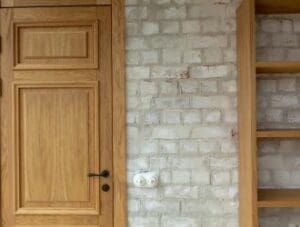Guide to Treat Oak Doors

Need to treat your oak doors but not sure where to start?
This no-nonsense guide provides you with what you need: effective treatment techniques for every type of oak door.

Build your door today!
Get a Quote
We’ll help you choose the right tools, prepare your oak wood door, and apply the finish, ensuring equal protection and style.
Detailed yet to the point, this is the only article you’ll need for treating oak doors and maintaining their timeless appeal.
Wooden Door Treatment - Overview
- Oak doors are chosen for their durability, and they come in various forms, such as solid oak, veneer oak, and engineered oak, each offering different benefits and levels of resistance to environmental changes.
- Proper preparation and treatment of oak doors require specific tools and techniques, such as sanding with the correct grit sandpaper, using the right brushes or rollers, and applying treatment coats in the direction of the wood grain.
- Oak doors require regular daily cleaning with a microfibre cloth and periodic deep cleaning with a mild detergent or vinegar. Repair methods include sanding, applying filler, or using dowels for splits and cracks in case of damage.
Understanding Oak Wood Doors
Some of you won't have oak or wooden doors in your home, as it is just one of the many types of doors you can have, so we will explain what they are and their different features here.
Renowned for their sheer durability, oak doors have long been favoured for their resistance to wear and tear.
The dense grain of oak makes them an ideal choice for high-traffic areas where their resistance to sagging, dents, and scratches truly shines.
Internal oak doors are a popular option for homeowners seeking both style and functionality. Unfinished oak doors offer the opportunity to customise the finish to match your interior design preferences.
However, oak doors come with a variety of distinguishing features. They come in:
- Solid oak doors are made entirely of oak and offer the most authentic look and feel. However, while their robustness is unmatched, their susceptibility to environmental changes can be a drawback.
- Veneer oak doors are made with a thin layer of oak veneer over a core material. They look similar to solid oak doors but are more affordable and less prone to warping.
- Engineered oak doors: made with a solid core and a thin layer of oak veneer on the surface. They are more stable than solid oak doors and less likely to warp or shrink.
Each type of oak door has its unique set of advantages and drawbacks.
Veneer oak doors, on the other hand, boast a layer of real oak on an engineered core.
This design imparts impressive durability and minimal expansion or contraction, ensuring consistent performance over time. It makes it a great alternative to bare interior wood doors.
Engineered internal oak doors feature a genuine oak lipping and an engineered core, offering enhanced stability and reduced susceptibility to warping compared to solid oak alternatives.
Essential Tools for Oak Door Treatment
If you fancy doing some oak door treatment yourself, there is a list of things you can and should use for the best results.
Specialised tools required for treating oak doors include:
- 80-120 grit sandpaper for oiling
- No smoother than 240 grit sandpaper for OSMO oil treatments
- Synthetic bristle brushes
- Flat brushes
- Microfibre rollers
- Varnish paint brushes
Each tool is pivotal in the treatment process, ensuring an evenly applied, durable finish that enhances the door’s natural beauty.
While these tools are vital for a perfect finish, ensuring safety is equally important. Protective gear such as:
- dust sheets
- sanding pads
- safety masks
- goggles
- latex gloves
are very important to ensuring a safe working environment.
Prepare to Treat Wooden Doors
Proper preparation of the door surface is a prerequisite before beginning the treatment process. This involves removing stains and dirt and sanding the surface to ensure proper treatment adhesion.
Oak doors can also be treated if you have done some door stripping to remove paint, as the aftercare smooths it all out and creates a more elegant look.
Sanding is a critical step in this preparation process. Here are some tips to follow:
- Use sandpaper that is no smoother than 240 grit.
- Sand the entire door, focusing on areas where treatment will be applied.
- Ensure a clean door surface before sanding.
- Adhere to safety precautions like using dust sheets, safety masks, goggles, and sanding pads.
Following these tips will help you achieve the best results for your door treatment.
Removing Stains and Dirt
The preparation process begins with the big step of removing stains and dirt from your oak door. Before applying any cleaning solution, ensure the door is clean and dry.
Also, it’s advisable to test the solution on a small area to observe any potential adverse reactions.
Addressing light stains on interior oak doors can be done by:
- Wiping the door with a clean, dry cloth.
- Apply a mixture of a small amount of white vinegar and olive oil to the stain to further aid in its removal.
- Using 240 or 320-grit sandpaper to carefully sand the affected area can be quite effective for stubborn stains.
Sanding Techniques
Sanding is a vital preparation step before treating oak doors. Using 80-120 grit sandpaper facilitates better oil absorption into the wood and offers enhanced protection.
To achieve a uniform surface after sanding an oak door, follow these steps:
- Begin by using 240 or 320-grit sandpaper to meticulously sand the entire door.
- If applying multiple coats, lightly sand between coats.
- Vacuum the surface after sanding to eliminate any dust.
Choose the Treatment for Your Oak Door

With a range of treatments for wooden doors, you can ensure that your oak door is cared for and receives the full TLC experience.
Choosing an appropriate treatment for your oak wood door is key to maintaining its quality and visual appeal.
Factors such as the door’s location (interior or exterior), the desired finish, and maintenance requirements influence the treatment choice.
When treating internal oak doors, it’s essential to consider these factors to ensure the door’s longevity and appearance.
Oil treatments, wax finishes, and varnishing are some options available. Each has unique benefits and considerations, making it vital to understand them before deciding.
You can also clean the door handle to give your door an even more elegant and clean look.
Depending on the door’s exposure to moisture, for instance, a treatment that safeguards against moisture would be more suitable.
Oil Treatments
There are multiple benefits of using oil to treat oak doors, such as enhancing the appearance of a treated oak door.
This treatment removes the grain, creates a gentle shine, and protects against moisture, dirt, and finger marks.
Different types of oil treatments offer varying benefits, so you can decide what is the best oil for oak doors. Here are a few examples:
- Tung oil: flexible when it hardens, has waterproofing qualities, and provides great benefits for longevity and durability.
- Danish oil enriches the oak doors' aesthetic by conserving the wood's natural hue and mitigating water damage.
- Hard wax oil offers greater durability than traditional wood wax and easier maintenance than varnish.
Wax Finishes
Wax finishes serve multiple purposes for oak wood doors:
- They act as a protective barrier against moisture, preventing warping.
- They contribute to maintaining a clean surface by preventing dirt buildup.
- They accentuate the inherent beauty of the oak’s grain, providing a refined and glossy look that enriches its lustre and shine.
To effectively apply wax finishes, the wax should be worked along the wood grain, dried, and then polished to achieve the desired shine. This ensures a smooth and even finish.
Varnishing
Varnishing an oak door not only enhances its natural beauty but also provides a protective seal against moisture, dirt, and finger marks.
The varnish treatment offers a resilient, protective layer that aids in the conservation of the wood and shields it from harm caused by water, sunlight, and other environmental elements.
To treat oak veneer doors, follow the same process to ensure a long-lasting and visually appealing finish.
The process of applying varnish involves removing all door furniture, applying the varnish, wiping off any excess, and finishing with a pad to achieve a high-quality result.
Coat Application for Wooden Oak Doors
Correct coat application is key to achieving a durable and attractive finish on wooden doors.
The process involves evenly applying the initial coat, allowing it to dry according to the manufacturer’s instructions, and then applying additional layers as needed.
Achieving a uniform coat on a wooden door requires a synthetic bristle brush or a lint-free cloth to apply a thin layer of the treatment.
It’s also essential to allow adequate drying time between coats to ensure the longevity of the finish.
First Coat Application
The first coat application is a key step in the treatment process.
It’s essential to work in the direction of the wood grain during this step, as it significantly influences the wood’s response to the treatment and its structural integrity.
Following the sanding or repair of the damage, it’s important to reapply the suitable treatment to the area to restore and match the finish of the rest of the door.
This ensures a seamless blend with the surrounding surface and restores the door’s natural beauty.
Applying Additional Layers - How to Oil Doors
Applying additional treatment layers is necessary to maintain the door’s protective barrier and appearance. The recommended waiting time before applying an additional coat varies depending on the type of treatment used.
Before applying additional layers, it’s recommended to:
- Lightly sand all faces and edges with fine sandpaper to ensure proper adhesion and smoothness for the subsequent layer.
- Use a brush or cloth for oil application.
- Use a dust sheet to protect the surrounding area.
- Use a microfibre cloth to wipe away any excess oil.
- Use a wide paintbrush to apply the oil evenly.
- Use sanding pads to smooth out any rough areas.
These steps on how to oil doors are key to achieving a strong and durable repair.
Regular Cleaning and Maintenance of Oak Doors

Unfortunately, the brand-new, elegant look your wood door has after treating it doesn't stay forever.
But there are things you can do to keep it looking that way.
Regular cleaning and maintenance are required to maintain the beauty and durability of oak doors.
Cleaning oak wooden doors is very similar to cleaning composite doors, due to the wooden materials composite doors use.
This not only enhances their aesthetic appeal but also prolongs their lifespan.
Cleaning and maintenance practices largely depend on the type and frequency of door usage.
More frequent cleaning and maintenance may be required for doors in high-traffic areas or those exposed to harsh weather conditions.
Daily Maintenance
Simple daily maintenance tasks can significantly impact the longevity and appearance of oak doors. Wiping down your oak door with a microfibre cloth can prevent dust accumulation and maintain the door’s sheen.
While daily cleaning is vital, it’s also important to be gentle to prevent any unnecessary damage to the door. Therefore, when wiping down oak doors, it’s recommended to use a clean, dry microfibre cloth.
Periodic Deep Cleaning
Periodic deep cleaning is necessary for maintaining clean oak wood doors daily. This involves using a mild detergent solution or a vinegar solution and a soft cloth or sponge to remove stubborn stains and grime.
Based on their exposure to dirt and usage, oak doors should undergo periodic deep cleaning, either monthly or weekly. This practice is essential for preserving their appearance and structural integrity in the long run.
Oak Wood Door Problems
Homeowners will know better than anyone that not everything is perfect, and the same applies to oak doors.
Sometimes, they can have problems that can be very annoying, but almost all of them can be solved with a variety of fixes.
Despite their durability, oak doors can sometimes experience issues like:
- Scratches
- Dents
- Splits
- Cracks
- Warping
Promptly addressing these issues is vital to prevent further damage and maintain the door’s appearance and functionality.
Many of these issues are brought up in the composite doors vs. wooden oak doors debate, with composite doors having fewer issues.
Various methods can be employed to repair these damages. Here are some options:
- Scratches can be smoothed out using treatment wax or sanding the area and blending it with the surrounding wood.
- Wood filler or putty can be effective for more significant damage, such as splits or cracks.
- Another option is to drill a hole near the crack, apply wood glue, and insert a dowel for a more durable solution.
Repairing Minor Damage
Minor damages, such as scratches or dents, can detract from the oak door's overall appeal. However, these can be effectively addressed by sanding and reapplying the appropriate treatment.
In addition to sanding, scratches can be smoothed out using treatment wax or by rubbing the inside of a walnut.
Dents can frequently be raised by placing a damp cloth over them and allowing the moisture to expand the wood fibres.
Reapplying Treatment
Over time, the treatment on the oak door may wear off, requiring reapplication. It is recommended that oak doors be re-treated every two or three years to maximise longevity.
Reapplying treatment involves removing all door furniture, applying the oak oil or varnish, removing any excess, and finishing with the finishing pad for a high-quality result.
Oak Door Treatment - Our Verdict
With all that said, oak doors, with their natural beauty and durability, can truly enhance the aesthetic appeal of any space. However, maintaining their charm requires understanding proper treatment and maintenance.
From choosing the right type of oak door to selecting the appropriate treatment, each decision plays a huge role in ensuring the door’s longevity and beauty.
Regular maintenance, including daily and periodic deep cleaning, is vital to preserving the door’s appearance and structural integrity.
Similarly, promptly addressing scratches, dents, splits, or cracks can prevent further damage and maintain the door’s functionality.
Treating and maintaining your oak door is a worthwhile endeavour. Not only does it preserve the door’s natural beauty and durability, but it also ensures that it remains a captivating feature in your space for years to come.
FAQs
Is it best to oil or varnish oak doors?
It is best to use a clear door oil to enhance the natural grain of oak doors, while varnishes provide the best protection in terms of durability.
Oils and waxes, on the other hand, are easier to maintain and repair.
What is the best oil for oak doors?
Deciding the best oil for wooden doors depends on what you are looking for in your oil oak door treatment. Hard wax oil, tung oil, and Danish oil all have different effects and qualities on your door.
What is the best protection for oak doors?

The best protection for oak wood doors is:
Water-based stains from reputable brands like Osmo Door Oil 3060 or Osmo Door Oil 3033 if you prefer oil.
These treatments provide excellent protection for internal oak doors.
They will also likely work on composite doors that have been treated, as faded composite doors may require a finish at the end to make them look brand-new again.
Can you leave oak doors untreated?
It is not recommended to leave oak doors untreated as they will be more vulnerable to moisture, dust, and stains, leading to potential damage.
Consider applying a suitable treatment to protect the doors.
What are the different types of oak wood doors?
Oak doors come in solid, veneer, and engineered variations, each with unique advantages and drawbacks. Choose the type that best suits your needs and style preferences.
What tools are needed for oak door treatment?
To treat an oak door, you will need 80-120 grit sandpaper, synthetic bristle brushes, microfibre cloths, and protective gear like dust sheets, safety masks, goggles, and latex gloves.
What is the best finish for internal oak doors?
There isn't a correct choice for the best finish for internal oak doors, as there are a number of finishes that can be used on the doors and the best one is completely up to you.
Some homeowners will prefer an oil finish, whereas others will want a varnish or a wax finish. It is completely up to you to decide the best finish for interior wooden doors!









